4-1: Ground-Based Air Defence
Ground-Based Air Defence Objectives
The role of Ground-Based Air Defence (GBAD) is to defeat or reduce the effectiveness of enemy offensive airpower.[1] GBAD is an integral part of air, land, and – in littoral cases – maritime battles. GBAD contributes to land forces manoeuvre by engaging hostile aircraft with missiles; collecting information for the ADF’s air battle management system (ABMS); and providing advice to commanders, their staff, and units on the air threat and passive AD measures.[2] GBAD units will often be tasked to defend vital assets or locations against an air threat. These units will also be tasked to destroy any air asset. Aircraft are a valuable and scarce resource, so their destruction both protects friendly forces and allows unhindered movement over the battlefield, while also weakening the adversary.[3]
Ground-Based Air Defence Systems
The RAA is tasked to provide Short-Range (SR)-GBAD in support of ADF operations. Specifically, the RAA defends deployed forces and critical assets from air threats and facilitates the integration and synchronisation of air and land effects. An integrated air and missile defence system will be a core component of SR-GBAD, as will the ability to track and neutralise unmanned and autonomous systems.[4]
The latest GBAD systems also take advantage of the latest datalink technology, which allows GBAD units to have weapon systems geographically dispersed but still connected. This also allows the sensors to both receive and send data, adding to the wider air defence picture.
LAND 19-7B Short Range Ground-Based Air Defence (SR-GBAD)
| This project will introduce a modern SR-GBAD capability, able to protect the Joint Land Force[5] and provide interoperability into the wider ADF Integrated Air and Missile Defence (IAMD) Systems[6]. It will introduce a highly mobile capability able to protect manoeuvre forces with advanced sensor systems able to contribute to the threat picture enabling Joint assets and land fires platforms.[7] The advanced, highly technical nature of this project will require changes to existing training and simulation systems within the people system.[8] |
Australia: Kongsberg – Norwegian/National Advanced Surface to Air Missile System (NASAMS)

The NASAMS Canister Launcher, firing an AMRAAM missile[9]
The NASAMS is a distributed and networked medium-to-long-range air-defence system. A typical unit comprises of a command post, an active 3D radar, a passive electro-optical and infrared sensor, and a number of missile canister launchers. The system uses Advanced Medium-Range Air-to-Air Missiles (AMRAAM) and holds six missiles per Multi-Missile Launcher. The launcher supports firing of AIM-120 AMRAAM B/C5/C7, AMRAAM ER, and AIM 9-X Sidewinder Block II.[10] The AMRAAM missiles will have a range of about 20 km.[11]
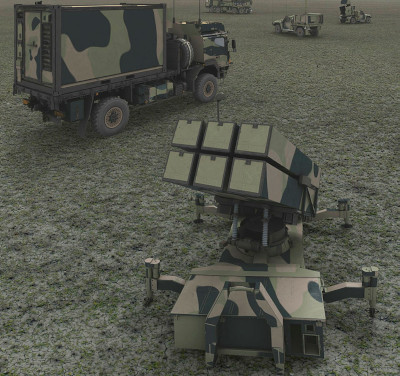
Australian Army NASAMS[12]
The GBAD systems outlined below illustrate short-to-medium-ranges of around 8 to 40km distance. The role these systems play is changing from traditional fast air and rotary-wing platforms to engaging UAVs and, in some cases, missiles. New technology has provided for these systems to be operated in all weather – day or night – with improved ability to identify, track, and effect targets.
Russian Federation: Ulyanovsk Mechanical Plant – Pantsir-S1

Pantsir-S1[13]
The Pantsir-S1 is an 8x8 truck-mounted medium-range anti-aircraft gun and missile system. It can alternatively be mounted on a track chassis like the GM-352 chassis in the photo above. The system incorporates two 30mm cannons and up to 12 missiles, allowing it to engage up to four targets simultaneously. Its missions vary from intercepting tactical aircraft, precision-guided munitions, and UAVs. It has been in service since 2003 and the latest upgraded models have a range out to 40km. It is currently operated by 13 countries, including Algeria, Brazil, Jordan, UAE, and Vietnam.[14]
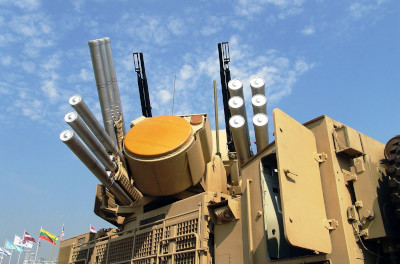
Pantsir-S1 Weapon System[15]
United Kingdom: Matra BAE Dynamics – JERNAS / Rapier FSC
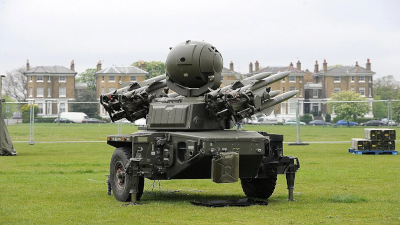
Rapier FSC[16]
The Rapier FSC is a towed trailer launcher, short-range missile system. It is mounted with eight missiles and is able to fire two simultaneously, with a full reload carried out manually in 2 minutes. It is capable of engaging supersonic, low-level, high manoeuvrability aircraft as well as UAVs, cruise missiles, and rotary-wing aircraft.[17] Rapier FSC has been in service since 1996 and has a range out to 8km, with a radar detection range in excess of 15km. It uses an electro-optical tracking device and passive infra-red sensors, and is controlled by an operator at a weapon control terminal.[18] Rapier FSC is currently operated by 11 countries, including Iran, Indonesia, UAE, Malaysia, and Singapore.
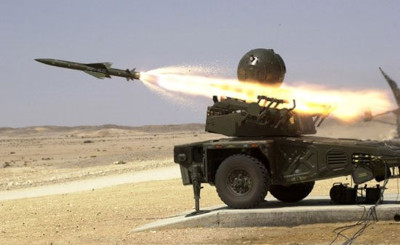
Rapier FSC firing[19]
Israel: Rafael Advanced Defense Systems – SPYDER
Named after the Python 5 and Derby missiles the system uses, the Surface-to-air Python and Derby (SPYDER) is a short-to-medium-range, truck-mounted air-defence system. It can be mounted on multiple truck chassis, with the short-range variant holding four missiles, and the medium-range variant holding eight. It is capable of engaging aircraft, helicopters, UAVs, and precision-guided munitions.
SPYDER entered service in 2008. Its short-range variant has a range out to 15km and ceiling of 30,000ft, while the medium-range variant has a range of 35km and a ceiling of 50,000ft. The radar unit has a range of 40km and can track up to 60 targets. A unit can be geographically dispersed up to 10km and takes 5 minutes to be set up. Once this occurs, the first missile can be launched in 5 seconds. Countries with SPYDER currently in service include India, Georgia, Peru, Singapore, and Vietnam.[21]
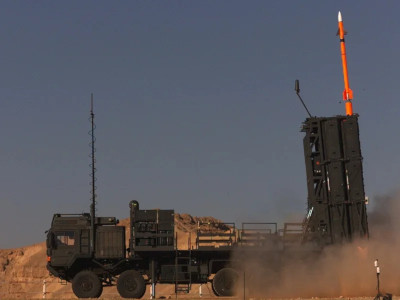
SYPDER Surface-to-Air Launcher[22]
4-2: Surveillance and Target Acquisition
Surveillance and Target Acquisition Objectives
The role of surveillance and target acquisition (STA) is to conduct systematic surveillance and accurate target acquisition and targeting in order to enable field artillery to provide fire support.[23] STA systems combine the means of acquiring information and targets and carrying out an appropriate level of target information processing. The STA system incorporates a cyclical process which informs, directs, and updates the priorities and the rate of the collection effort.[24] As such, STA systems perform the function of observer in the Gunnery Problem, informing the delivery systems of target information.
STA units conduct surveillance[25] in conjunction with other arms to collect and disseminate tactical information, as well as dedicated target acquisition[26] of enemy forces. The location of enemy artillery (including mortars) is vital to prosecute counter-battery fire against an adversary’s indirect fire threat.[27]
Surveillance and Target Acquisition Systems
The type of payloads that aerial STA systems can carry include advanced electro-optical and infrared systems, planned synthetic-aperture radar and moving target indicator, hyperspectral imagery, lightweight communications relay package, marker/illuminator, laser rangefinder, and target designator.[28] This suite allows the observer/controller to identify and gain targeting information for a target, as well as build the intelligence picture to support deployment of artillery assets. It also can aid in battle damage assessment after an artillery mission.
The smaller of the UAVs discussed have the ability to operate within 150km-600km range, and for the larger ones around 5,000 kilometres, while being able to remain on task for over 8 hours. These systems are now designed with interchangeable optics and sensors depending on the mission, or as upgrades occur, allowing it to remain relevant throughout the platform’s lifecycle. They bring better situational awareness to the battlespace commanders not only through video footage, but also information across the electromagnetic spectrum, and improve the observer’s ability to identify, track and engage targets, and then assess the effectiveness of the engagement. Some UAVs have become true multi-role platforms with the ability to carry missiles and bombs, adding to the effects that joint fires can deliver.
LAND 129-3 Tactical Unmanned Aerial Vehicle Enhancements/Upgrades
| This project will increase the surveillance, reconnaissance and targeting function of the preparedness system[29] to observe the environment in multiple spectra[30], providing greater flexibility and situational awareness. The support system will be capable of introducing new sensor pods to maintain capability assurance[31] throughout life and be capable of accepting technological updates. This project will require personnel growth to the current capability and advancement in simulation systems within the people system.[32] |
LAND 129–4 Unmanned Aerial Vehicle (UAV)
| Small Unmanned Aerial System (SUAS) will deliver enhanced situational awareness and increased force protection. The project is a new capability which will provide organic Intelligence, Surveillance and Reconnaissance (ISR) support primarily for land force operations. LAND 129 – 4 particularly supports battlespace awareness in land combat operations including littoral manoeuvre.[33] Land 129-4 SUAS will provide the tactical commander with a ‘flying pair of binoculars’ capability for enhanced day/night surveillance and reconnaissance in order to reduce the threat to soldiers attempting to identify enemy locations or activity.[34] |
Australia: AAI Corporation (Textron Systems) – RQ-7B Shadow 200
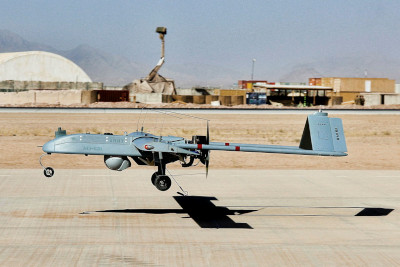
RQ-7B Shadow 200[35]
The Shadow 200 UAV is used to locate, recognise, and identify targets up to 125km from an operations centre. It operates at an altitude of 8,000ft and carries a suite of high-resolution cameras and sends footage and data in real-time to ground terminals. It has approximately 8hrs endurance and can carry a payload of 27kg.
The system can be catapult-launched from a hydraulic rail launcher and can use a conventional wheeled landing on a flat surface or use a deployable arresting hook for ground based arresting cables.[36]
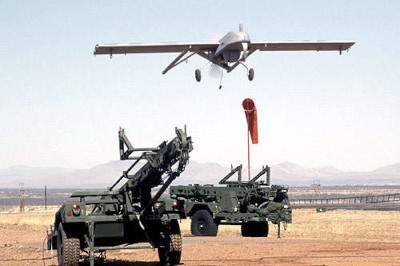
RQ-7B Shadow 200 and hydraulic rail launcher[37]
A selection of comparable class and tier UAVs operated by military forces around the globe include the following examples:
United Kingdom: Thales – WK450 Watchkeeper
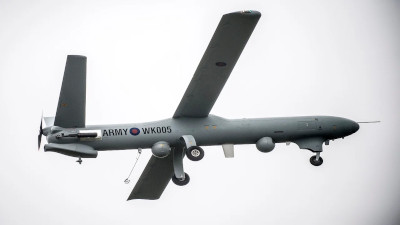
WK450 Watchkeeper[38]
The Watchkeeper is a dual-sensor, all-weather UAV used in theatre by the Royal Artillery. It has a range of 150km from a ground control station, can fly at altitudes of 16,000ft with a maximum speed of 77kts and has an endurance of 14hrs. It has a payload capacity of 150kgs and has an automatic take-off and landing capability.[39]
Watchkeeper’s primary purpose is to provide targeting data for artillery and rocket strikes.[40] Additionally, Watchkeeper also provides intelligence, surveillance, target acquisition and reconnaissance through its payload, which includes day/night sensors, a laser designator, and a synthetic-aperture radar/ground moving target indicator.[41]
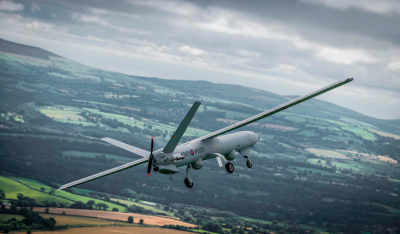
Watchkeeper UAV[42]
People’s Republic of China: Chengdu Aircraft Industry Group – Wing Loong II

Wing Loong II UAV on parade[43]
The Wing Loong II is a medium-altitude, long-endurance UAV. It has a range of 4,000km, can fly at altitudes of 16,000ft with a maximum speed of 150kts and has an endurance of 20hrs. It has a payload of 200kgs and takes off and lands conventionally on a flat surface. The UAV is intended primarily for surveillance and aerial reconnaissance mission requirements for the People’s Liberation Army-Air Force. It also has six under-wing hardpoints, giving it the ability to be fitted with air-to-surface missiles or laser-guided bombs.[44]
Wing Loong II’s electro-optical payload pod, fitted under the forward section of the fuselage, is integrated with visual light and infrared cameras and sensors to collect surveillance and targeting data in both day and low-light/night conditions. The UAV is also equipped with synthetic-aperture radar, laser designator, forward-looking infrared (FLIR) camera, and electronic countermeasures. This system is in use with the UAE, Saudi Arabia, Kazakhstan, Pakistan, Algeria, Egypt, Indonesia, Nigeria, and Uzbekistan.[45]
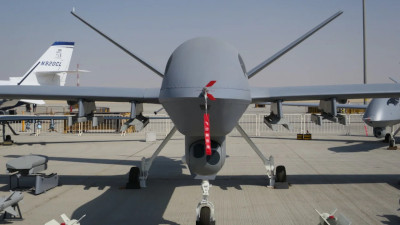
Wing Loong II on the flight-line[46]
Russian Federation: Special Technology Center – Orlan-10
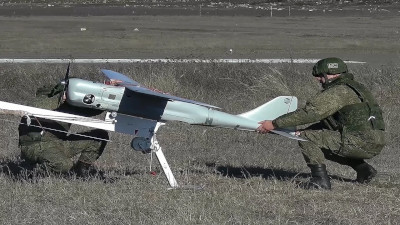
Orlan-10 about to be launched[47]
The Orlan-10 is a medium-range multi-purpose UAV whose production commenced in 2010. It has a range of 600km, flying up to altitudes of 16,000ft with a maximum speed of 80kts and with an endurance of 16hrs. It has a payload of 6kgs, is launched using a collapsible catapult, and is retrieved by a parachute landing system.
Orlan-10 is intended for a variety of missions including aerial reconnaissance, observation, monitoring, search and rescue, combat training, jamming, radio signals detection, and target tracking in hard-to-reach terrain.[48]
4-3: Digital Terminal Control Systems
Digital Terminal Control Objectives
The observer’s enduring role is to identify and coordinate delivery of effects onto a target in a timely manner while keeping friendly forces safe. This involves sending information about the location of the observer and the location and details about the target. Once the target has been engaged, further information may be required to adjust the engagement to optimise the effect on the target. Before digitisation, adjustment was done via voice and required transmission and read-back to ensure accuracy.
Digital Terminal Control System
In a joint fires situation involving two or more fire units in a co-ordinated action to produce the desired effects, multiple fire units or even units from different services may be involved. This increases the time and complexity of disseminating the required information via voice.
Digitisation has allowed the use of direct data transfer, which has resulted in greatly increased access to situational awareness, and an ability to exchange large volumes of information more quickly than via voice.
LAND 17-2 Digital Terminal Control System, Next Generation
| This project will increase the networked sensor density of the preparedness system and access to ADF and coalition joint fires from the air, maritime, and land. It will provide a technological refresh cycle[50] from the support system to ensure interoperability is maintained as new, more capable RAA and Joint Systems are introduced into service. It will provide both an agile and responsive training and doctrine[51] assurance function to the people system through user feedback and dedicated knowledge management.[52] |
LAND 8111 Artillery and Digital Terminal Control System (DTCS) Replacement
| This project builds on the lessons learnt and experiences of DTCS NextGen. DTCS Replacement will provide enhanced targeting and fire control capability across the battle space. The need to provide technical refresh on software and hardware of the DTCS suite will see a reduced refresh cycle in order to maintain the leading-edge technological advances within this capability. LAND 8111 will provide direct linkages to the advanced field artillery tactical data system, which when paired with the DTCS, further digitally enhances the coordination, planning, and execution of joint fires across the joint force.[53] |
Australia: Digital Terminal Control System
The Digital Terminal Control System (DTCS) is a system used by the observer to create targeting data so a fire unit can engage and then make adjustments. It is a lightweight soldier-carried system including a tablet PC, laser rangefinder, laser target designator, GPS receiver, and real-time video downlink receiver. It allows observers to precisely fix the location of identified targets, then feed the data through to the fire unit for targeting and designate the target via laser for incoming weapons systems.[54]
Australia’s selected DTCS will greatly enhance the ADF’s joint fires capability by allowing communication to mortars, artillery, strike aircraft, helicopters, and ships.[55]

Soldier using DTCS[56]
Conclusion
Over 150 years of defending Australia, the focus of how Australian artillery’s combat power has evolved from primarily supporting infantry, to supporting the entirety of the Australian Defence Force. As the RAA commemorates 150 years of artillery service to Australia and looks back on where it has come from and how the focus of artillery has changed, this opportunity equally offers a great opportunity to look forward and see where the RAA is heading. The introduction of new technologies has accelerated, increasing the speed and tempo that modern battles have been fought. In response to this, and aided by these new technologies and sensor developments, the footprint of artillery systems has become more geographically dispersed. Collectively, this has greatly increased the complexity and difficulty of solving the gunnery problem.

Observer using long-range thermal imager[57]
Australian artillery’s past has often prioritised and focused on the weapon and platform, particularly during extended peacetimes. In contrast, the RAA’s future demands a committed focus on command and control, as well as targeting. Weapon and platform remain ever important, but as the foundations of solving the Gunnery Problem, it is the RAA’s command and control and its targeting that will ensure the future ready RAA’s operational and strategic relevance in Australia’s geo-strategic environment.
Strategic updates and guidance from the Australian Government have acknowledged the modernisation and improved precision of the weapon systems that peer and counterpart countries will acquire over the period to 2035. The Artillery Modernisation Plan (AMP) has been put in place to substantially upgrade the RAA’s current weapons systems, platforms, and support force elements to attain parity with or generate overmatch of potential enemy threats, and to provide ongoing upgrades to those systems to remain potent and relevant.
Each capability area identified in the AMP contributes substantively to the Force Structure Plan,[58] and supports the strategic defence objectives identified in the Defence Strategic Update.[59]
Self-propelled artillery will allow increased protection and range with the ability to maintain a mechanised battle tempo, while improvements to ammunition will allow in-service and future artillery systems to deliver firepower with improved accuracy. The long-range fires program will provide Australia an increased ability to shape the battlespace by defeating threats to our forces at ranges out to 300 km. The DTCS will enhance the speed of engagement as well as access to a larger number of weapon platforms which can engage targets. New UAS assets will provide better sensors to improve targeting. These UAS platforms will also allow better situational awareness for commanders and enhance our intelligence, surveillance, and reconnaissance capabilities. This will support a range of missions from counterterrorism, to augmenting our surveillance capability for search and rescue, humanitarian assistance and disaster relief missions.
This paper’s horizontal scan of Australia’s peer artillery forces has given an opportunity to consider characteristics of contemporary in-service platforms that Australia could seek to emulate or acquire as potential future capabilities. The capabilities that the RAA will bring to the ADF are unique in their ability to rapidly change the strategic effect that the ADF can have at long range. The long-range fires platform has the quickest, cheapest, and easiest path for introduction into service of any next generation platform able to range out to 500 km.
Transitioning from off-the-shelf purchases of allied long-range fires platform for initial capability, through to a developing sovereign manufacturing capability would provide Australia a robust logistics capability even under conditions of constrained supply environments. The careful acquisition of such new platforms could not only allow interoperability with our traditional allies, but also maintain Australia’s technological edge and capability superiority over potential adversaries. Above all, the introduction of the new systems and platforms in the AMP will significantly enhance the combat power the RAA can deliver for the Australian Defence Force and position it to carry on its ubiquitous and enduring presence for another 150 years.









